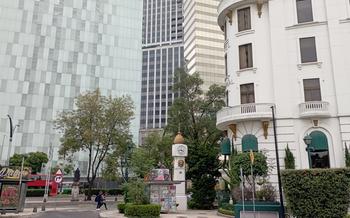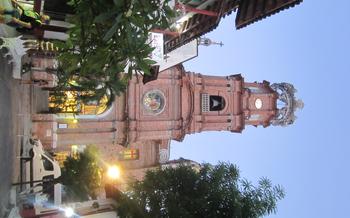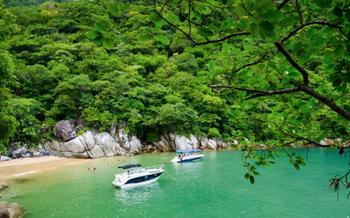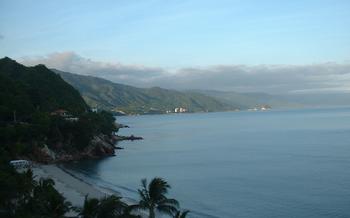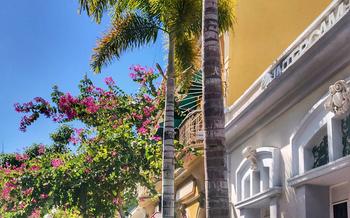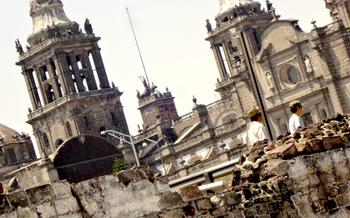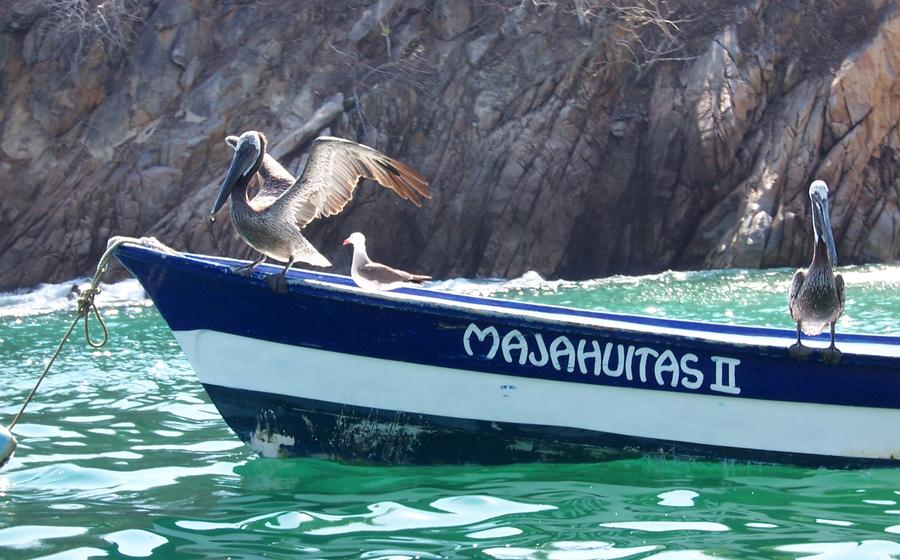
Majahuitas
- Majahuitas: A paradise in Puerto Vallarta. Theoretical notions:
- How to get there: practical suggestions.
- What to see and do in Majahuitas:
- Where to eat in Majahuitas
- Where to stay in Majahuitas
- Best time to visit Majahuitas:
- Things to keep in mind
- Majahuitas's role in the local economy:
- Majahuitas's cultural significance:
- Majahuitas's environmental importance:
- Majahuitas's future: between sustainable tourism and development
- Famous visitors to Majahuitas
- Stories and legends of Majahuitas:
- Majahuitas in popular culture
- Insider Tip: Hidden Gems of Majahuitas
Majahuitas: A paradise in Puerto Vallarta. Theoretical notions:
Origin of the name: The name "Majahuitas" comes from the Nahuatl word "Maza-hua", which means "place of deer". This is because Majahuitas was once a hunting ground for the native peoples of the region.
Location and geography: Majahuitas is a small, secluded beach town located on the Pacific coast of Mexico, in the state of Jalisco. It is situated about 25 kilometers south of Puerto Vallarta, in the municipality of Cabo Corrientes. Majahuitas is surrounded by lush tropical forests and the Sierra Madre mountains and is known for its beautiful beaches, clear waters, and abundant marine life.
History: The history of Majahuitas dates back to the pre-Columbian era when the area was inhabited by the indigenous peoples of the region. In the 16th century, the Spanish arrived in Majahuitas and established a small settlement. However, the settlement was abandoned after a few years due to the lack of water and resources. In the 19th century, Majahuitas was rediscovered by fishermen from Puerto Vallarta, who used the area as a fishing camp. In the 20th century, Majahuitas began to attract tourists, and in the 1970s, it was declared a national park.
Geology: Majahuitas is located in a geologically complex region. The area is composed of various rock formations, including sedimentary rocks, volcanic rocks, and metamorphic rocks. The most prominent geological feature of Majahuitas is the Punta Mita headland, which is a large peninsula that juts out into the Pacific Ocean. The headland is composed of volcanic rocks and is a popular destination for hikers and birdwatchers.
How to get there: practical suggestions.
Reaching Majahuitas is a breeze. Several transportation options are available, depending on your budget and preferences.
-
Public transportation: The most economical option is to take a bus from Puerto Vallarta to Boca de Tomatlán, a nearby town. From there, you can hop on a water taxi to Majahuitas. The journey takes about an hour and costs around $10-$
-
Water taxi: If you're staying in Puerto Vallarta's hotel zone, you can take a water taxi directly to Majahuitas. The ride is more scenic and takes about 30 minutes. Expect to pay around $20-$30 for a round trip.
-
Private boat: For a more exclusive experience, you can rent a private boat to take you to Majahuitas. This option offers more flexibility and allows you to explore the surrounding coves and beaches at your own pace. Prices vary depending on the size of the boat and the duration of the rental.
No matter which transportation option you choose, be sure to arrive early to avoid the crowds. During peak season, the beaches can get busy, especially on weekends.
What to see and do in Majahuitas:
Beaches: Majahuitas Beach is the main attraction, offering crystal-clear waters, soft white sand, and stunning views of the surrounding mountains. Playa La Lancha is another popular option, known for its excellent snorkeling opportunities.
Snorkeling: The underwater world of Majahuitas is teeming with marine life, making it a paradise for snorkelers. You can spot colorful fish, sea turtles, and even manta rays. Snorkeling tours are available, or you can rent your own gear and explore at your own pace.
Kayaking: Kayaking is a great way to explore the coastline of Majahuitas and discover hidden coves and beaches. You can rent kayaks at several locations in town, and guided tours are also available.
Zip line: For a thrilling experience, try the zip line that takes you soaring over the jungle canopy. You'll get breathtaking views of the surrounding mountains and coastline.
Hiking: There are several hiking trails in Majahuitas, ranging from easy walks to more challenging treks. You can hike through the jungle, along the coastline, or even up to the top of the nearby mountains.
Where to eat in Majahuitas
The culinary scene in Majahuitas is as diverse as the natural beauty that surrounds it. From casual beach shacks serving up fresh seafood to upscale restaurants offering gourmet dishes with stunning ocean views, there is something to satisfy every palate and budget.
Types of cuisine
The cuisine in Majahuitas is predominantly Mexican, with a focus on fresh seafood caught daily from the Pacific Ocean. You can find everything from simple fish tacos to elaborate ceviches and grilled lobster. There are also a number of international restaurants offering Italian, French, and Asian cuisine.
Prices
Prices in Majahuitas are generally reasonable, especially compared to other popular tourist destinations in Mexico. You can expect to pay around $10-15 for a main course at a mid-range restaurant. If you are looking for a more upscale experience, expect to pay around $25-35 per person.
Recommended restaurants
Some of the most popular restaurants in Majahuitas include:
- La Casita del Pescador: This casual beach shack is known for its fresh seafood, especially the fish tacos.
- La Isla: This upscale restaurant is located on a private island and offers stunning views of the Pacific Ocean. The menu features a variety of international dishes, including seafood, steak, and pasta.
- La Terraza: This rooftop restaurant offers a unique dining experience with views of the town and the surrounding mountains. The menu features a mix of Mexican and international dishes.
Insider tips
- If you are on a budget, there are a number of great food stalls and markets where you can find delicious and affordable meals.
- Be sure to try the local specialty, pescado zarandeado, which is a grilled fish marinated in a spicy sauce.
- Many restaurants in Majahuitas offer happy hour specials, so be sure to take advantage of these if you are looking to save money.
Where to stay in Majahuitas
Types of accommodation
Majahuitas offers a variety of accommodation options to suit all budgets and preferences. From rustic beachfront bungalows to luxurious villas, there's something for everyone.
Prices
Prices for accommodation in Majahuitas vary depending on the type of property, the time of year, and the amenities offered. Expect to pay anywhere from $50 to $500 per night.
Recommended hotels
Some of the most popular hotels in Majahuitas include:
- Hotelito Desconocido: A secluded, adults-only resort with private beach, pool, and spa.
- Villas Las Estrellas: Luxurious villas with private pools and stunning ocean views.
- Hotel Majahuitas: A charming beachfront hotel with a variety of room types to choose from.
Insider tips
- Book your accommodation in advance, especially if you're traveling during the peak season (December to April).
- Consider staying in a hotel or villa with a kitchen so you can save money on food.
- Ask about discounts and special offers when booking your accommodation.
Best time to visit Majahuitas:
The best time to visit Majahuitas is during the dry season, which runs from November to April. During this time, the weather is sunny and dry, with average temperatures ranging from 25 to 30 degrees Celsius. This is the ideal time to enjoy all the outdoor activities that Majahuitas has to offer, such as swimming, snorkeling, kayaking, and hiking.
The rainy season runs from May to October, and while it can be a beautiful time to visit Majahuitas, the weather can be unpredictable, with heavy rains and thunderstorms. However, the rainy season also brings lush vegetation and fewer crowds, so it can be a good time to visit if you're looking for a more peaceful and secluded experience.
If you're planning to visit Majahuitas during the shoulder seasons (May and November), be prepared for a mix of weather conditions. The weather can be sunny and dry, or it can be rainy and humid. It's important to pack for all types of weather, just in case.
No matter what time of year you visit Majahuitas, you're sure to have a memorable experience. This beautiful and diverse destination has something to offer everyone, from sun-seekers and beach lovers to nature enthusiasts and adventure seekers.
Things to keep in mind
When visiting Majahuitas, it is essential to keep in mind a few things to ensure a safe and enjoyable experience.
Safety is generally good in Majahuitas, but it is recommended to take precautions as in any unfamiliar place. Walking alone at night is not advisable, and valuables should not be left unattended.
What to bring to Majahuitas depends on the activities planned. For a day at the beach, essentials include sunscreen, a hat, sunglasses, and a swimsuit. Snorkeling or kayaking enthusiasts should bring their equipment or rent it locally. Good hiking shoes and comfortable clothing are necessary for exploring the trails.
Etiquette and local customs should be respected. Greetings with a handshake or a kiss on the cheek are common. It is customary to ask permission before taking photos of local people. Bargaining is acceptable in local markets, but it should be done respectfully. Tipping is customary in restaurants and for services rendered.
It is essential to be aware of the local customs and traditions. Respecting the local culture and traditions is essential, as it helps to preserve the unique character of Majahuitas. It is also important to be mindful of the environment and to avoid littering or damaging the natural beauty of the area.
Majahuitas's role in the local economy:
Majahuitas plays a pivotal role in the local economy, offering employment opportunities, generating income, and promoting sustainable practices. The tourism industry is the primary source of income, with numerous hotels, restaurants, and tour operators providing jobs to the local community. The influx of tourists brings revenue to the area, which is reinvested in infrastructure, education, and social programs.
Majahuitas is committed to sustainable tourism, emphasizing preserving the environment and promoting responsible practices. Local businesses prioritize eco-friendly initiatives such as using renewable energy sources, recycling, and waste reduction. These efforts not only protect the pristine environment but also contribute to the long-term economic viability of the region.
The conservation efforts in Majahuitas have led to various initiatives, including the establishment of marine sanctuaries, reforestation programs, and the protection of endangered species. These projects not only safeguard the natural heritage of the area but also create employment opportunities in conservation and research.
Majahuitas's role in the local economy extends beyond tourism, as fishing and agriculture also contribute to the livelihood of the community. The fertile lands around the village support farming activities, providing fresh produce for local consumption and sale in nearby markets. The fishing industry, with its rich marine life, provides employment for local fishermen and contributes to the local food supply.
The economic benefits of Majahuitas are not limited to monetary gains but also encompass the preservation of traditional practices and cultural heritage. The tourism industry provides a platform for local artisans to showcase and sell their handcrafted goods, perpetuating traditional skills and generating income.
Overall, Majahuitas's role in the local economy is multifaceted, encompassing tourism, conservation, agriculture, and fishing. The sustainable practices adopted by the community ensure that economic growth and environmental protection go hand in hand, creating a thriving and resilient local economy.
Majahuitas's cultural significance:
Majahuitas is a place of great cultural significance, as it is home to several indigenous communities who have lived in the area for centuries. These communities have their own unique traditions, festivals, and gastronomy, which are all part of the rich cultural heritage of Majahuitas.
One of the most important indigenous communities in Majahuitas is the Huichol people. The Huichols are a semi-nomadic people who have lived in the Sierra Madre Occidental mountains for centuries. They are known for their colorful yarn paintings, which depict their mythology and beliefs.
Another important indigenous community in Majahuitas is the Coras. The Coras are a sedentary people who have lived in the area for over 2,000 years. They are known for their pottery, which is often decorated with intricate designs.
The festivals of Majahuitas are a major part of the town's cultural life. One of the most important festivals is the Feast of Our Lady of Guadalupe, which is celebrated every December 12th. This festival is a celebration of the Virgin Mary, who is the patron saint of Mexico.
Another important festival in Majahuitas is the Feast of San Juan Bautista, which is celebrated every June 24th. This festival is a celebration of Saint John the Baptist, who is the patron saint of fishermen.
The gastronomy of Majahuitas is also a major part of the town's cultural heritage. The town is known for its fresh seafood, which is often prepared in traditional Mexican dishes. Some of the most popular dishes include ceviche, fish tacos, and shrimp cocktails.
Overall, Majahuitas is a place of great cultural significance, with a rich history, traditions, and gastronomy. The town is a great place to learn about the indigenous cultures of Mexico, and to experience the vibrant festivals and cuisine of the region.
Majahuitas's environmental importance:
Majahuitas is home to a diverse array of flora and fauna, making it an important ecological destination. The lush vegetation includes tropical trees such as mahogany, cedar, and rosewood, as well as various species of orchids, bromeliads, and ferns. The surrounding waters are teeming with marine life, including colorful fish, sea turtles, dolphins, and whales. Majahuitas is also a nesting site for sea turtles, making it a crucial habitat for these endangered species.
The diverse ecosystems found in Majahuitas include tropical dry forest, mangrove forests, and coral reefs. These ecosystems provide important habitat for a variety of species and play a vital role in the overall health of the region. The coral reefs, in particular, are a critical ecosystem as they provide food and shelter for a wide range of marine life.
Majahuitas has a conservation status of "Natural Protected Area", which means that it is legally protected from development and other activities that could harm the environment. This status helps to ensure that the natural beauty and biodiversity of Majahuitas will be preserved for future generations.
Majahuitas's future: between sustainable tourism and development
Majahuitas is at a crossroads. Its popularity as a tourist destination has brought economic benefits to the region, but it has also raised concerns about the impact of tourism on the environment and the local culture.
The challenge for Majahuitas is to find a way to balance the benefits of tourism with the need to protect its natural and cultural resources. This will require careful planning and management, as well as the cooperation of all stakeholders, including the government, the private sector, and the local community.
A number of initiatives are already underway to promote sustainable tourism in Majahuitas, and these are having a positive impact on the environment and the local economy. For example, the use of solar and wind power is increasing, and there is a growing emphasis on recycling and waste reduction.
At the same time, the government is working to improve infrastructure and services in Majahuitas, such as roads, water supply, and sewage treatment. This will help to reduce the impact of tourism on the environment and improve the quality of life for local residents.
The future of Majahuitas is bright. With careful planning and management, it can become a model for sustainable tourism.
Here are some of the opportunities that exist for Majahuitas:
- Increased tourism revenue: With its stunning beaches, lush rainforests, and rich culture, Majahuitas has the potential to attract even more tourists in the future. This will generate revenue that can be used to improve infrastructure and services, protect the environment, and support the local economy.
- Job creation: Tourism can create jobs in a variety of sectors, including hospitality, transportation, and retail. This can help to reduce unemployment and improve the quality of life for local residents.
- Cultural preservation: Tourism can help to preserve the local culture of Majahuitas. By showcasing the region's traditions, festivals, and cuisine, tourism can help to ensure that these traditions are passed down to future generations.
- Environmental protection: Tourism can help to protect the environment of Majahuitas. By promoting sustainable practices, such as recycling, waste reduction, and the use of renewable energy, tourism can help to reduce the impact of human activity on the environment.
The future of Majahuitas looks promising. With careful planning and management, it can become a model for sustainable tourism and a place where visitors and locals can enjoy the beauty of nature and the richness of the local culture.
Famous visitors to Majahuitas
Majahuitas has been graced by the presence of a number of celebrities, politicians, artists, and athletes over the years. Among them are:
- Celebrities: Brad Pitt, Angelina Jolie, Jennifer Aniston, George Clooney, Julia Roberts, Leonardo DiCaprio, and Tom Cruise have all been spotted enjoying the sun and sand of Majahuitas.
- Politicians: Former Mexican President Vicente Fox and former U.S. President Jimmy Carter have both visited Majahuitas, as well as a number of other high-ranking officials from around the world.
- Artists: Majahuitas has also been a popular destination for artists of all kinds, including painters, sculptors, musicians, and writers. Some of the most famous artists who have visited Majahuitas include Pablo Picasso, Frida Kahlo, Diego Rivera, and Carlos Fuentes.
- Athletes: Majahuitas has also been a popular destination for athletes, including surfers, swimmers, and divers. Some of the most famous athletes who have visited Majahuitas include Laird Hamilton, Kelly Slater, and Greg Louganis.
These famous visitors have all been drawn to Majahuitas for its stunning beauty, its laid-back atmosphere, and its world-class amenities. Majahuitas is a truly special place that has something to offer everyone, from celebrities to politicians to artists to athletes.
Stories and legends of Majahuitas:
Majahuitas is a place steeped in history and tradition, and as such, it has its fair share of myths, legends, and folklore. One of the most popular stories is that of the mermaid of Majahuitas. According to legend, a beautiful mermaid once lived in the waters off the coast of Majahuitas. She was said to be kind and gentle, and she would often help lost sailors find their way back to shore. However, she was also said to be very shy, and she would only appear to those who were pure of heart.
Another popular legend is that of the treasure of Majahuitas. According to this story, a Spanish galleon carrying a fortune in gold and jewels was shipwrecked off the coast of Majahuitas in the 16th century. The treasure was said to have been buried on the beach, and many people have searched for it over the years. However, no one has ever been able to find it.
Finally, there is the story of the ghost of Majahuitas. According to this story, the ghost of a young woman who was murdered on the beach still haunts the area. She is said to appear to people who are walking alone at night, and she is said to be very angry.
These are just a few of the many stories and legends that are told about Majahuitas. Whether you believe them or not, they are all part of the rich cultural heritage of this beautiful place.
Majahuitas in popular culture
Majahuitas has been featured in numerous forms of popular culture, from movies and TV shows to books and music. Its stunning scenery and rich cultural heritage have made it a popular destination for filmmakers, authors, and musicians alike.
In the 1980s, Majahuitas was featured in the popular Mexican telenovela "Rosa Salvaje." The show, which was filmed on location in the village, helped to introduce Majahuitas to a wider audience and boost tourism to the area.
More recently, Majahuitas has been featured in several Hollywood movies, including "The Shawshank Redemption" (1994) and "Predator" (1987). The village's unique beauty and secluded location have made it a popular choice for filmmakers looking for a tropical paradise to set their stories.
Majahuitas has also been featured in several books, including the novel "The Power of One" (1992) by Bryce Courtenay. The book tells the story of a young boy who grows up in South Africa during the apartheid era. The boy's family is forced to flee the country and they eventually settle in Majahuitas. The book provides a vivid description of the village and its people, and it has helped to raise awareness of Majahuitas' rich cultural heritage.
Finally, Majahuitas has also been featured in several songs, including the popular Mexican song "La Bamba." The song, which was written by Ritchie Valens in 1958, tells the story of a young man who falls in love with a girl from Majahuitas. The song has become a classic and it is still popular today, both in Mexico and around the world.
Insider Tip: Hidden Gems of Majahuitas
Beyond the well-trodden tourist spots, Majahuitas conceals a treasure trove of hidden gems waiting to be discovered by adventurous souls. Secluded beaches, tucked away amidst lush vegetation, offer tranquility and breathtaking views. Explore off-the-beaten-path trails that lead you through the heart of the jungle, revealing hidden waterfalls and secret swimming holes.
Seek out local hangouts where you can mingle with the friendly residents and immerse yourself in the authentic culture of Majahuitas. Engage in lively conversations, sample local delicacies, and learn about the fascinating traditions and customs of this vibrant community.
Don't miss the opportunity to capture the essence of Majahuitas through photography. With its stunning landscapes, colorful wildlife, and vibrant local life, every corner of this paradise is a photographer's dream. Discover the best spots for photography, where you can capture breathtaking sunsets, dramatic rock formations, and candid moments of everyday life in Majahuitas.

